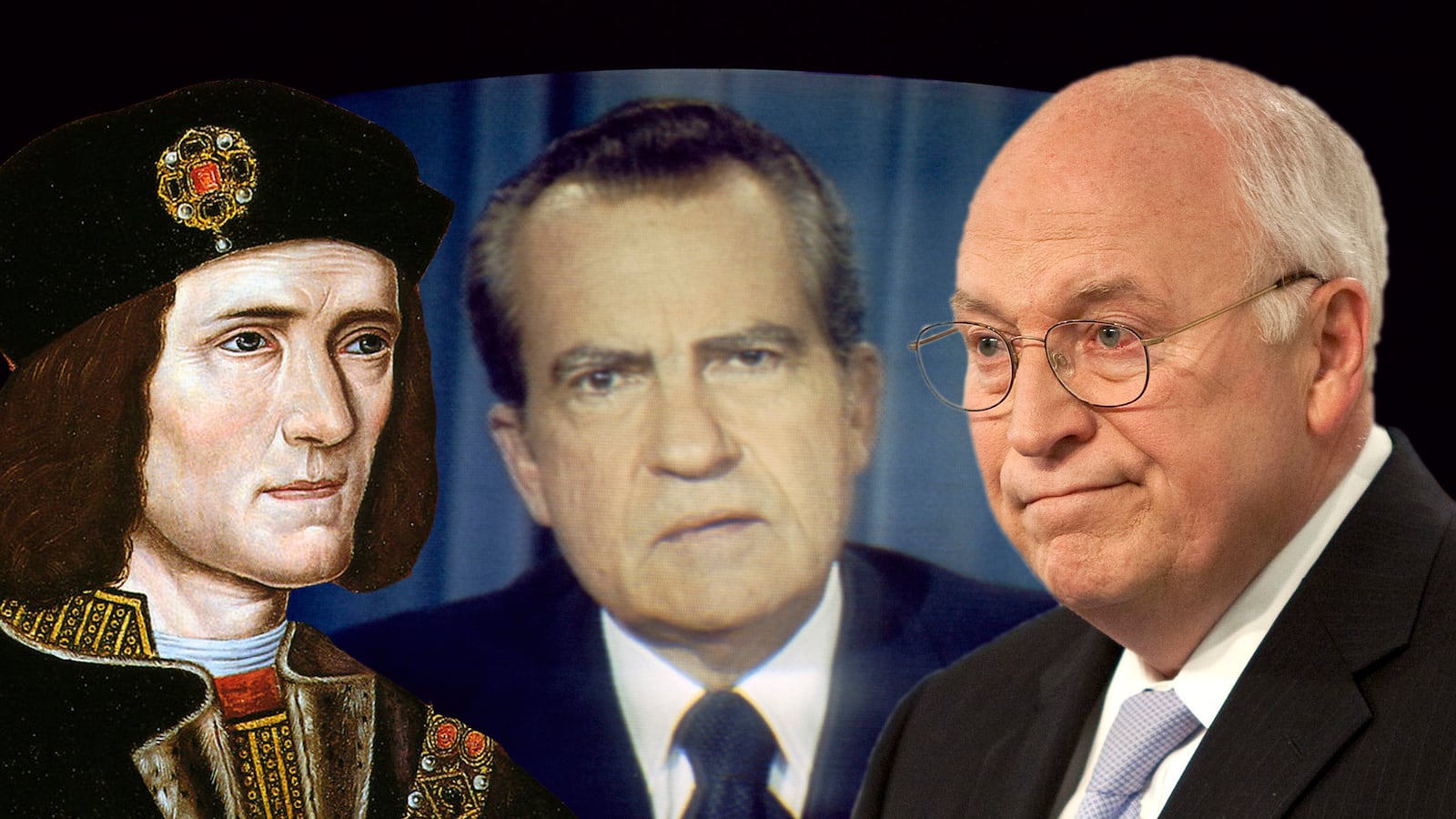You have to admire their nerve. This summer Dick Cheney, his wife Lynne and daughter Liz have embarked upon a sustained campaign of reputation rehabilitation. Invading Iraq was “absolutely the right thing to do.” No apologies needed.
They are a united and defiant trio. They need to be. Barring a few co-conspirators from the neocon academy, nobody else is interested in supporting them. Even Fox News responded incredulously to Cheney’s assertion that the current collapse of Iraq was all Obama’s fault and had nothing to do with him.
The Cheneys exhibit indecent haste in their attempt at rep rehab. This is usually posthumous, left to historians. In the fullness of time it is possible to see beyond the fleeting moments of a life to a more balanced and complete picture. Records are combed, correspondence revealed, skeletons fall out of cupboards.
That has certainly been the case with two other famous Dicks. One is a relatively recently departed figure whose long shadow still inhabits our political life. The other has been dead for well over five centuries.
Let us begin with the long dead, Richard III, he of the hunchback and withered limb – if you believe Shakespeare’s version, which you should not.
There has recently been a boom in the Richard III industry. This was triggered in 2012 by the discovery of a skeleton beneath a parking lot in the English city of Leicester. Forensic tests, including DNA, have since established that the bones were indeed those of Richard III (there remain a few dissenters but they should be discounted).
The heinous deed that forever makes a villain of Richard was the murder in the Tower of London of two young princes aged twelve and nine. The eldest, Edward V, had succeeded his father, Edward IV. Until he was mature enough to rule, the child had been placed under the supposed care and protection of his uncle Richard.
In 1483 the princes were publicly declared illegitimate by a cleric. A few days later they vanished, and with great speed Uncle Richard was made king.
It was without doubt all very fishy, but Richard left no fingerprints. The case against him has always been thinly circumstantial. In 1984 a British TV channel staged a criminal trial against Richard for the murders. Expert historians divided to argue the case for and against. The jury decided that the case was not strong enough to convict.
This case serves well as a study of how reputation can be influenced this way or that by the motives of later generations. The Tudors who succeeded Richard to the throne reinforced their own legitimacy by setting out systematically to trash him. Shakespeare, among others, was a willing accessory to this early act of character assassination as propaganda.
Now arrives a Richard III scholar, Chris Skidmore. In the latest issue of BBC History Magazine Skidmore has a piece called Inside the Mind of Richard III. It includes new material that will be in a book that Skidmore will publish next year.
However, before we get to the subject of Richard’s mind, we should pause to consider his stomach. Skidmore has an audit of what was offered at the king’s coronation banquet.
Some 3,000 guests were invited, who sat at 1,200 communal tables. Among the animals consumed were 30 bulls, 140 sheep, 100 calves, 12 fatted pigs, 200 suckling pigs, 1,000 geese, 800 rabbits, 800 chickens, and 2,400 pigeons.
Considering what was probably happening at the same time in the Tower of London, this was clearly as good a way as any of inducing a complaisant stupor among those who might otherwise have been keeping a wary eye on the suddenly enthroned.
Skidmore tells us that, in 1470 on the birth of the young prince Edward, Richard had declared his disinterested fealty to the reigning king and his heir by saying “In case hereafter it happen you by God’s disposition to overlive our sovereign lord; I shall then take and accept you for the very true and rightwise king of England.”
Somewhat coyly, Skidmore admits that “Richard was to break this solemn vow in spectacular style.”
As for the usurper’s reputation, Skidmore presents a very forgiving view – Richard was a devout family man, unlike his debauched predecessor Henry IV, and he counters rumors that Richard poisoned his wife Anne by quoting him saying only a few days before her death, “our most dear wife the queen.” Moreover he told his bishops that “our principal intent and fervent desire is to see virtue and cleanness of living to be advanced, increased and multiplied, and vices and all other things repugnant to virtue…to be repressed and annulled.”
So, if that is to be believed, he was a bit of a prig. Or hypocrite. He certainly had grounds to be paranoid. He was never comfortable on the throne. Powerful rivals conspired against him. The most threatening was the Duke of Buckingham. Some historians believe that it was in fact Buckingham who had the princes murdered in order to frame Richard. In 1483 Buckingham raised a rebellion but it failed and he was executed.
Two years later Richard died in battle at Bosworth Field, whereupon the throne passed to the Tudors, whose own lusts and treachery make him look like an amateur in the arts of regicide.
The bones unearthed in the parking lot revealed that Richard did indeed have a deformity. His spine was curved, indicating the condition known as scoliosis. This meant that although he was about five feet eight inches tall, a manly height in that age, his right shoulder appeared higher than the left and he would have seemed shorter than he actually was. There was no withered arm. Put that down to the Tudors – as spookily performed by Laurence Olivier in the movie of Shakespeare’s play where he has the menace of a gait that is half crab and half spider.
We shall return to this hapless king, his parking lot and his last battle, but must now move right along to the third of our Dicks, Richard Nixon.
Unlike the Cheneys, here is a man whose misdemeanors came to torment him. And, eventually, who repented – famously on television during a remarkable series of interviews with David Frost. In that moment, when silent seconds go by as Frost waits and the camera moves into hard close-up, the former president reaches within himself and confesses that he let down the American people (and himself) by overseeing the Watergate break-in.
By no means is this cathartic. The impeachable crime is admitted but the guilt runs too deep to die so easily. And yet, from that moment on and for the rest his life Nixon saw his presidency reassessed, its achievements better understood when clear of the Watergate stain. Most notably we could see that this man, so petty and small-minded in his personal animosities, mentally crippled by grudges and perceived slights, had real presidential size in the big things, the biggest being his understanding that China could not be left in international limbo even though it was ideologically an adversary.
Nixon’s tragedy was partly to do with an irrational insecurity. He had no need of dirty tricks to win the 1972 election; there was nothing he could possibly learn from burgling the Democratic files that would have changed what turned out to be an astounding victory by winning 49 states. But he kept bad company. The Nixon tapes reveal a grisly gang of conspirators listening obediently to Nixon’s diatribes about people in his own service that he could not trust and about a legion of enemies, real or imagined, who had to be dealt with. Had Richard III been able to install a tape recorder in his palaces the ranting might well have been identical.
Yet as the opening to of China displayed Nixon’s historical literacy his domestic policy also gave him credentials that his own party would today find intolerable and today’s Democrats can only dream of. One act says it all: Nixon established the Environmental Protection Agency. Concerned about dangerous pollution of the public water supply and the increasing toxicity of the air because of industrial emissions, Nixon believed that only one instrument was available to effectively counter the special interests of polluting business: the federal government.
These days the Republican base is so far to the right that nobody with Nixon’s belief in the role of government would be a viable candidate. In a new Republican administration, the EPA might well become an endangered species. Thus the extreme polarity of American politics has had the strange effect of transforming Nixon’s ideological reputation. Tricky Dicky is no more: he’s an exemplar of political moderation.
Nobody could say that about Dick Cheney. Perched up on the battlements in his cowboy hat, unrepentant and more and more choleric, he has even said that military budgets need replenishment whatever the cost. “Forget food stamps, repairing highways,” he snarls.
Only somebody with Cheney’s breathtaking historical and cultural illiteracy could have his degree of certitude that hard power is the only tool that can make America safe. Within days of 9/11 he was talking about a “crusade” to avenge the blow, without realizing how freighted that word was. This medieval mindset framed all of his subsequent actions. He has learned nothing and – even more alarming – regrets nothing. As a result, his rep rehab remains a lonely and futile mission.
In the meantime, spare a thought for the unquiet passage of Richard III, last warrior of the Plantagenet dynasty. After Bosworth, his remains were buried in what was then the graveyard of Greyfriars Friary, before the modern city of Leicester existed. Once disinterred from the parking lot, they became the subject of rival claims. A bunch of atavists called the Plantagenet Alliance insisted that Richard be reburied far away from the scene of his defeat, in York, which they consider the dynastic seat. Most historians argued that he should remain in Leicestershire, and be reburied in Leicester Cathedral – and, after a court hearing, they prevailed.
But history is a continually turbulent river, often making subtle changes of course. It has recently been proved that what was thought to be the site of Bosworth Field wasn’t. The actual field, where Richard was unhorsed and slain in a medieval marsh, is more than a mile away to the southwest. Despite this revision, the Bosworth Field Visitor Center will remain in the village where it is, closer to the wrong site. The name of the village? Sutton Cheney.






